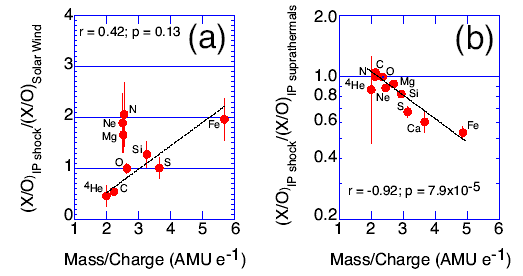
| ACE News Archives | ACE News #71 - May 21, 2003 |
ACE News Archives |

Enhancements in the intensities of energetic ions above ~0.1 MeV/nuc. at interplanetary (IP) shocks driven by coronal mass ejections (CMEs) are generally believed to occur due to the acceleration of a source population composed of solar wind ions. The acceleration process - a first-order Fermi mechanism - is presumed to depend on ion rigidity, or the mass (M) to charge (Q) ratio, where ions with lower rigidity, i.e., lower M/Q, get accelerated more efficiently than higher rigidity ions. We investigated the dominant seed population for IP shocks and the possible occurrence of rigidity-dependent mechanisms by comparing the average abundances of ~0.75 MeV/nuc. 4He-Fe nuclei measured by the Ultra Low Energy Ion Spectrometer (ULEIS) at 72 shock events observed at ACE between October 1997 and October 2002 with those measured in candidate sources, as shown above. Figure (a) shows that the IP shock abundances showed no smooth systematic trend with M/Q when compared with solar wind abundances (r and p denote the linear correlation coefficient and its statistical significance). The lack of a clear dependence on M/Q is difficult to reconcile with simple acceleration models if the dominant source of material accelerated at the IP shocks in our survey originated from the solar wind.
In Figure (b) we compare the IP shock abundances with the average abundances of >0.1 MeV/nuc. suprathermal ions that were ubiquitous in the interplanetary medium upstream of the IP shocks. Between October 1997 and October 2002, we found that the suprathermal population at 1 AU was dominated by ions that were previously accelerated in 3He-rich flares (see ACE News #44) and large CME-related solar energetic particle (SEP) events. Figure (b) shows that the IP shock abundances exhibited a negative dependence on M/Q when compared with those of the interplanetary suprathermals, consistent with current rigidity-dependent acceleration mechanisms provided that the source material consisted predominantly of interplanetary suprathermal ions rather than solar wind ions. Thus, these new results have demonstrated that identifying the correct seed population is necessary to probe the basic physical processes occurring during shock acceleration.
This work was recently published in the Astrophysical Journal, Vol. 588, 1149-1162, 2003.
Contributed by M. I. Desai and G. M. Mason of the University of Maryland, J. R. Dwyer of Florida Institute of Technology, J. E. Mazur of the Aerospace Corporation, S. M. Krimigis and R. E. Gold of the Applied Physics Laboratory at the Johns Hopkins University, C. W. Smith of the University of Delaware, and R. M. Skoug of Los Alamos National Laboratory.
Last modified 21 May 2003, by